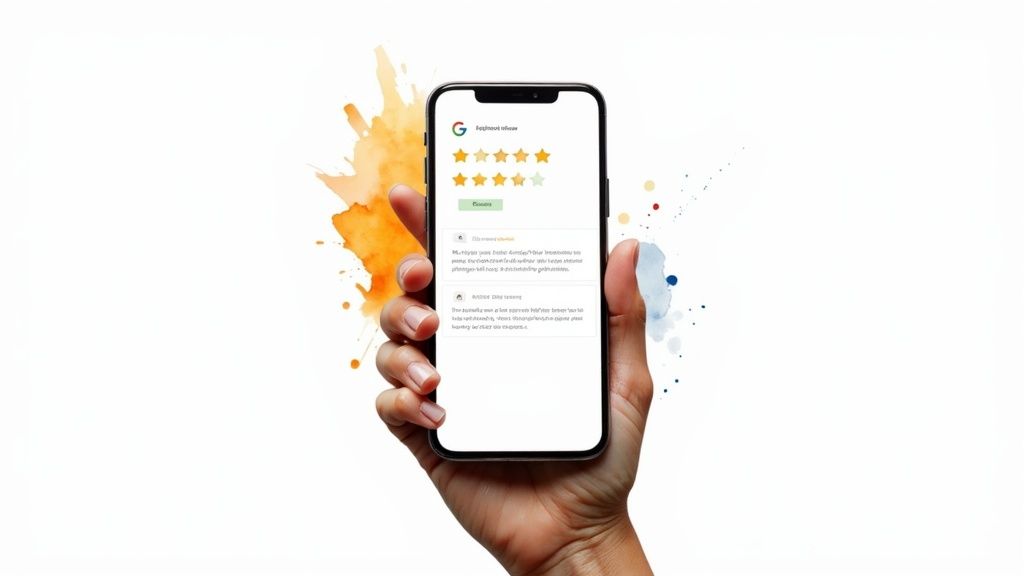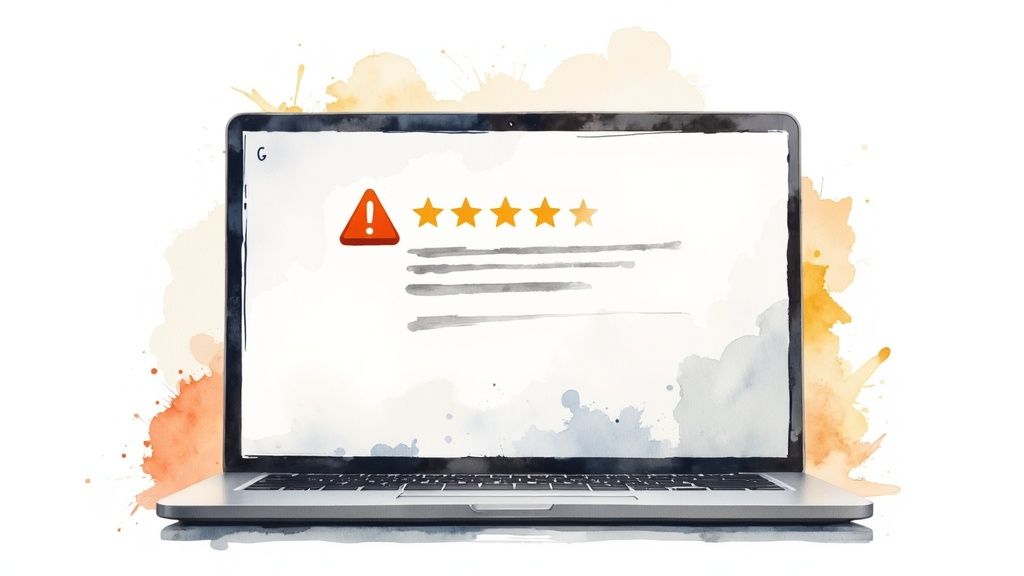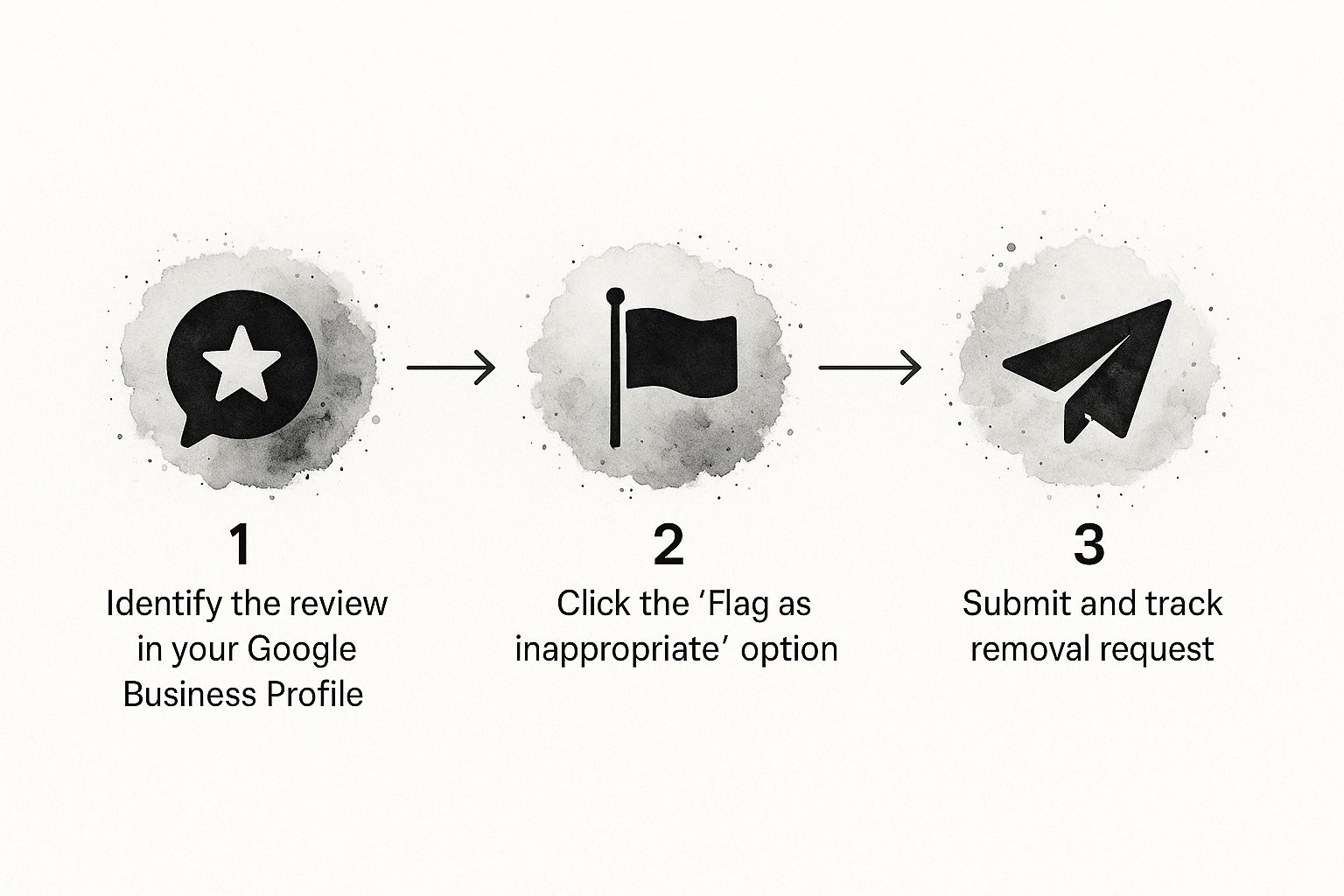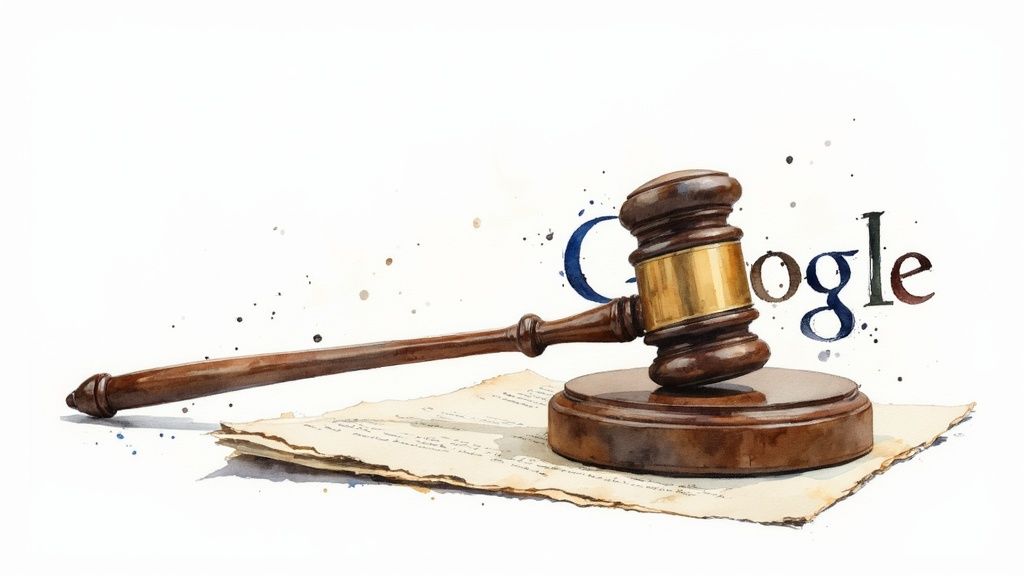So, can you remove Google reviews? The short answer is yes, but it’s not as simple as clicking a ‘delete’ button. You can only get a review removed if it specifically violates Google's content policies.
This is a crucial point many business owners miss. You can't just get rid of a negative review because you don't like it or feel it's unfair.
The Reality of Removing Google Reviews

Navigating the world of Google reviews can feel like walking a tightrope. A sudden one-star rating can feel like a direct attack, especially when you know it doesn't genuinely reflect your service. The key is to understand where Google draws the line between legitimate criticism and policy-violating content.
Google's platform is built on user-generated content, and they fiercely protect a customer's right to share their authentic experience—good or bad. This means a review detailing poor service, even if it's harsh, is generally protected. Think of it as Google prioritising the consumer's voice.
But that protection isn't unlimited. Google has firm boundaries, and when a review crosses into prohibited territory, you have the power to act.
Understanding Removable Content
You can successfully flag and request the removal of reviews that are clearly fake, spam, or completely off-topic. For instance, a review left by a competitor posing as a customer or one from a disgruntled ex-employee is a clear conflict of interest and is removable.
The same goes for content that is defamatory, uses hate speech, or includes personal threats—these are strictly forbidden.
A journalist on Reddit shared a wild story about a local cafe that was targeted by a competitor. The rival business owner created a dozen fake Google accounts overnight and blanketed the cafe's profile with identical one-star reviews. The cafe owner documented the coordinated, inauthentic nature of the attack in their report to Google, which resulted in all twelve reviews being scrubbed within a week.
This real-world scenario highlights the core principle: your removal case must be built on a clear policy violation, not just your dissatisfaction with the feedback.
Removable vs Non-Removable Google Reviews
It can be tough to tell what's a legitimate complaint versus a policy violation. This quick guide breaks down some common scenarios I've seen business owners face.
| Review Type | Is It Removable? | Why or Why Not |
|---|---|---|
| Spam or Fake Content | Yes | Reviews from bots, fake accounts, or containing promotional links violate Google’s policies. |
| Off-Topic/Irrelevant | Yes | A review ranting about politics or another business has nothing to do with your customer experience. |
| Hate Speech/Harassment | Yes | Reviews that attack individuals based on race, religion, gender, or other identities are strictly prohibited. |
| Conflict of Interest | Yes | A review from a current or former employee, or a direct competitor, is not an authentic customer experience. |
| Negative but Factual | No | "The service was slow and my coffee was cold." This is a legitimate (though negative) customer opinion. |
| Customer Disagreement | No | A customer who is unhappy with your pricing or return policy is allowed to express that opinion. |
Knowing the difference saves you time and helps you focus your energy where it matters—either by flagging a genuinely removable review or by crafting a professional public response to a legitimate negative one. This is the first and most critical step in managing your online reputation effectively.
Spotting Reviews That Break the Rules

If you want to get a Google review removed, you need to think less like a frustrated business owner and more like a Google policy enforcer. Simply disagreeing with a review or feeling it's unfair isn't enough to get it taken down. You have to build a case that clearly points to a specific violation of their content policies.
Think of it this way: each policy violation is a specific reason you can give Google to justify the removal. Are they a competitor trying to tank your rating? That's a clear conflict of interest. Is the review full of personal insults or threats? That falls squarely under harassment. You need to find the rule they've broken.
Common Policy Violations to Look For
Knowing what to look for makes spotting a violation much easier. While a genuinely unhappy customer leaving negative feedback is usually within the rules, many of the most damaging reviews are not. Here are some of the most common red flags that give you grounds for a removal request:
- Spam and Fake Content: This is a big one. It covers everything from reviews left by bots and fake accounts to content that’s been copied and pasted across multiple business profiles. A classic example is seeing a single user leave one-star reviews for ten different plumbers in Brisbane all within the same hour – that pattern stinks of inauthentic activity.
- Off-Topic Rants: The review must actually be about a customer's experience with your business. If someone leaves a one-star rant about the local council’s parking rules or the political bumper sticker they saw on an employee's car, it's irrelevant and can be flagged as off-topic.
- Conflict of Interest: This is a massive issue. A review from a disgruntled ex-employee trying to get even is a textbook conflict of interest and is explicitly against Google’s rules. The same goes for a competing business owner. Proving it can sometimes be a challenge, but it's a rock-solid reason for removal.
A journalist on Reddit recently highlighted a case where a restaurant owner successfully removed a one-star review that personally attacked them with comments completely unrelated to the food or service. By flagging it for 'Harassment', the owner proved that Google's policies protect business owners from personal attacks, not just fake reviews.
The sheer scale of fake content is staggering. In 2023 alone, Google zapped around 170 million fake reviews using a combination of machine learning and human moderators. For Australian businesses, this just goes to show that while Google is fighting the good fight, you still need to be proactive in flagging dodgy reviews to protect your own reputation. You can read more about the fight against fake reviews on CHOICE.com.au.
How to Flag a Review for Removal
Spotted a review that clearly breaks Google's rules? It’s time to take action, and the process kicks off right inside your Google Business Profile. Flagging the review is your official first step in asking Google to step in and take a look.
First up, you'll need to head over to the reviews section of your business profile. Find the exact review you want to challenge. Look for the three-dot menu icon right next to the reviewer's name—give that a click, and you'll see an option to "Report review." This is what gets the ball rolling.
Submitting Your Removal Request
Once you hit "Report review," Google will ask you why you're flagging it by showing you a list of potential policy violations. This part is crucial. You need to pick the reason that most accurately describes how the review crosses the line. Your choice here is your entire argument, so be specific and honest.
After you select the violation type, you just submit the report. There's no text box to add your own comments or plead your case, so the violation you choose has to do all the heavy lifting. If you want a more detailed walkthrough, this guide on how to remove a review from Google Business is a fantastic resource.
This simple infographic breaks down the basic flow: find it, flag it, and then track it.

The main takeaway here is that Google has designed the initial flagging process to be quick and direct, all handled from your dashboard.
Tracking Your Request's Status
After you've submitted your request, it becomes a bit of a waiting game. But you're not completely in the dark. You can keep an eye on things using Google's Review Management Tool. It's a dashboard that shows every review you've reported and its current status—whether it's "Pending decision," "Report reviewed – no policy violation found," or "Escalated."
One journalist on Reddit shared a pro tip they got from a reputation manager: "Always check the Review Management Tool before re-flagging. An 'escalated' status often means it's with a human for review. Bombarding the system won't speed it up and can actually hurt your case."
When Your Flagging Request Is Denied
Getting that dreaded "no policy violation found" email from Google is a special kind of frustrating. It’s easy to feel like you've hit a brick wall, especially when you know a review is fake or malicious.
This is the point where a lot of business owners just throw in the towel, but your first flag was only the beginning. It's time to escalate.
When the automated system lets you down, the next logical step is to appeal. If your initial flagging request gets knocked back, learning how to write an effective appeal letter is your best bet for getting a second look. This time, you’re hoping your case lands in front of an actual person who can see the context and nuance the algorithm missed.
But let's be honest, even a perfectly worded appeal sometimes isn't enough to dislodge a particularly nasty review. When you’re up against a truly damaging review and Google’s usual channels are getting you nowhere, it might be time to call in the professionals.
Turning to Professional Removal Services
For those really tough cases, specialist reputation management services can open up a much more powerful path to removal. These firms live and breathe Google's policies and Australian consumer law, using that deep expertise to build a rock-solid case that’s hard to ignore.
A journalist on Reddit shared an interesting take: "These reputation services aren't using magic wands. They're using a deep knowledge of legal precedent and policy loopholes to craft formal takedown requests that are much harder for Google's legal department to ignore than a simple flag from a business owner."
Here in Australia, these professional services have well-established processes for escalating issues directly with Google. They often bring in legal experts to pinpoint specific breaches of not just Google's terms, but also local laws, which adds a whole new level of seriousness to the request.
This formal application isn't some back-alley trick; it's a legitimate channel, and success often comes down to how well the evidence is presented.
Bringing in a service is a big decision, but for a review that’s causing real, substantial harm to your business, it offers a structured, expert-led strategy when you've exhausted every other option.
Mastering the Art of a Public Response

Sometimes the answer to "can you remove Google reviews?" is a hard no. When a negative review sticks to the rules, your best move isn't to fight it but to own it with a masterful public response.
A well-crafted reply can completely neutralise the impact of a bad review. Better yet, it shows potential customers browsing your profile that you’re professional, attentive, and genuinely committed to customer satisfaction. They aren't just reading the negative comment; they're watching how you handle the heat.
Crafting the Perfect Response
Your goal here is to de-escalate the situation and put your professionalism on full display. Whatever you do, never get into a public argument. The key is to acknowledge the customer's feelings—without necessarily admitting fault—and quickly move the conversation offline.
Here’s a simple but incredibly effective framework for your reply:
- Acknowledge and Thank: Kick things off by thanking them for their feedback, even if it’s tough to read. A simple "Thanks for bringing this to our attention" works perfectly.
- Show Empathy: Express regret that their experience wasn't up to standard. Try something like, "We're sorry to hear you were disappointed with the service."
- Take it Offline: This is the most crucial step. Provide a direct line to resolve the issue privately. "Please contact me directly at manager@business.com.au so I can learn more and help."
A journalist on Reddit shared a screenshot of a cafe owner's brilliant response that went viral: "Hi [Customer Name], I'm genuinely sorry your experience wasn't up to scratch. That's not the standard we aim for. If you could email me at [email], I'd appreciate the chance to make things right." The response was lauded as perfect—professional, empathetic, and it moved the conflict out of the public eye.
This approach stops a back-and-forth debate in its tracks. More importantly, it shows everyone watching that you take concerns seriously and are proactive about finding a solution. It flips a potential negative into a powerful display of excellent customer service.
Common Questions About Google Review Removal
Let's cut through the noise and tackle the questions I hear most often from Australian business owners about getting Google reviews removed. Here are some straight, no-nonsense answers to help you handle the process.
Can I Pay to Have a Bad Review Removed?
Unequivocally, no. It’s one of the biggest myths out there, and believing it can be a very expensive mistake. Google's removal process is tied strictly to its content policies—it has nothing to do with who's willing to open their wallet.
Any online service promising guaranteed review removal for a fee is almost certainly a scam. Steer clear. A legitimate reputation management expert will build a solid case based on actual policy violations, not try to buy their way to a solution.
How Long Does the Review Removal Process Take?
There's no single answer here; the timeline for a decision can vary wildly. While there isn't a fixed schedule, you can generally expect to hear back anywhere from a few days to several weeks.
What causes the delay? A few things:
- The Obviousness of the Violation: A review packed with hate speech will get taken down much faster than one you've flagged for a subtle conflict of interest.
- Google's Current Workload: If they're swamped with reports, everything slows down. It’s as simple as that.
- If You Need to Escalate: If your first request gets knocked back and you decide to appeal, the process naturally takes longer.
Does Flagging a Review Multiple Times Help?
Not at all. In fact, it could do more harm than good. Bombarding Google with multiple flags for the same review from your account won't speed anything up. Their system might even see this as spammy behaviour, which completely undermines the credibility of your request.
A single, well-documented flag that clearly points out the specific policy breach is always going to be more effective.
It's also crucial to remember that Australian businesses have to play by local rules. You can't just delete customer reviews you don't like. The ACCC has clear guidelines: while fake or misleading reviews are considered deceptive, genuine negative feedback is protected. This is why getting a review removed in Australia often means proving a clear policy breach through a formal application, because simply flagging it isn't a guarantee. You can find more insights into the legal side of fake review removal on Red Search.
Ready to take control of your search visibility and drive meaningful growth? The Brand Express delivers data-driven SEO strategies that connect you with high-value customers. Learn how our expertise can translate into commercial impact for your Brisbane-based business at https://www.thebrandexpress.com.au.

Pingback: How to Download Google Reviews A Complete Guide
Pingback: How to Optimize Google My Business